
Refer to PSP 25th Perihelion Campaign page.
2025-09-12 (CSV, PDF table of coordinates)
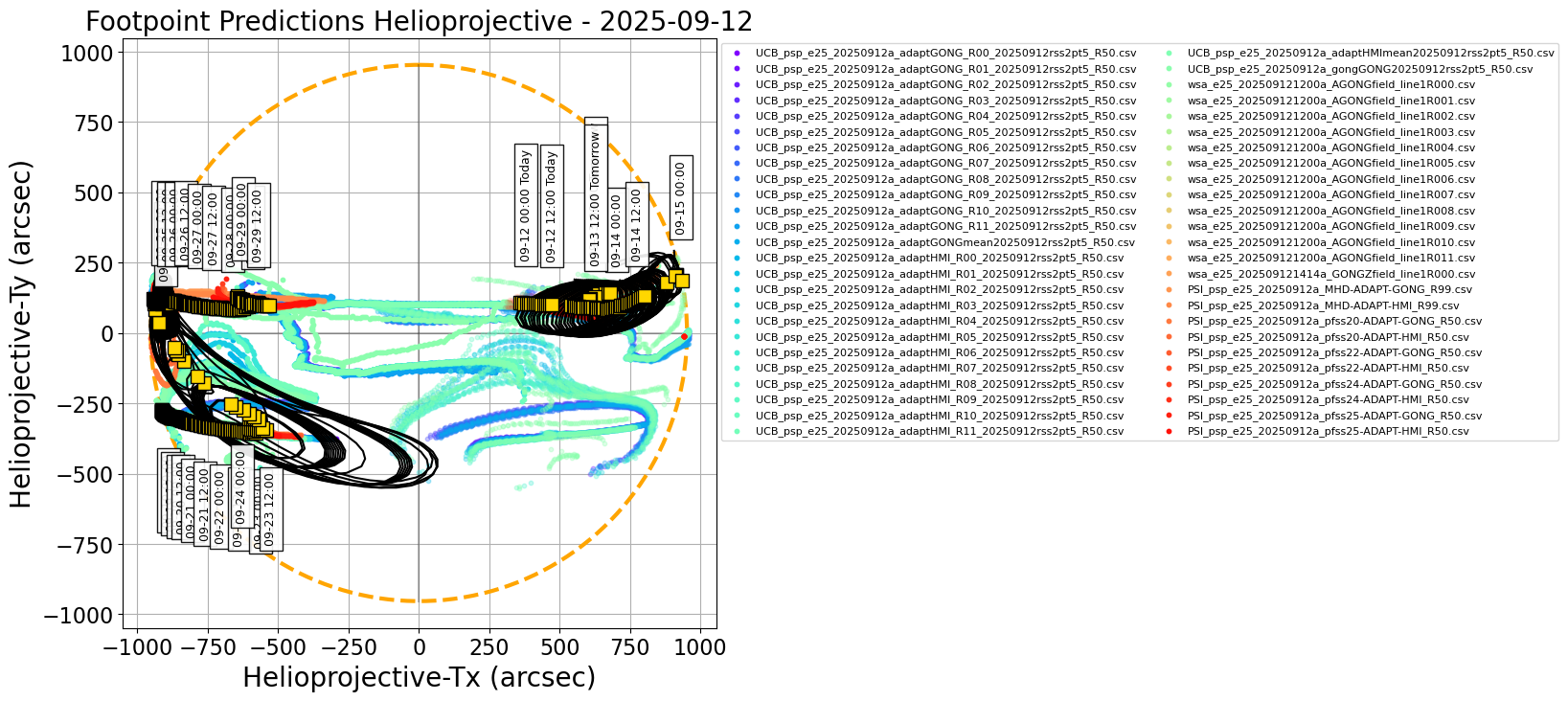
Figure 1.

Figure 2.
Figures above show one footpoint per day plotted on the solar disk and in Carrington coordinates (click on figure to zoom and see caption).
The predicted footpoints were kindly provided by the PSP 24rd Perihelion modeling team.
Encounter 25 Prediction update 1/7: 2025/09/12
------------------------------------------------
This is the first of seven daily footpoint predictions issued today through Thursday 9/18 for Parker Solar Probe Encounter 25. This is the fourth time Parker will reach its record-breaking perihelion of 9.86 Rs. Perihelion 25 occurs on Monday 2025/09/15 at 20:22 UT (16:22 EDT). Prior to perihelion, Parker sources concentrate on the West limb. As seen from Earth, Parker will move rapidly towards and beyond the plane of sky. Perihelion occurs on the far side of the Sun as seen by Earth, with footpoints going behind the limb when Parker reaches approximately 14 solar radii. Parker's rapid prograde motion takes it across the far side of the Sun in just a few days and is expected to emerge over the East limb on 09/18 about 25 Rs above the East limb. After this point, footpoints will be slowly changing and primarily associated with any sources or events on the East limb as seen from Earth.
Magnetic Connectivity
---------------------
For the next couple of days, Parker's footpoints are anchored to the westward edge of the prominent negative polarity coronal hole observable on disk today and will move with it as it rotates towards the West limb. Throughout this time, the spacecraft will be located above the West limb, moving progressively closer to the Sun.
The connectivity is predicted to drastically change in the early morning (~0200 UT) of 9/15, the day of perihelion, where it will cross the HCS and jump from the present source to a large positive polarity coronal hole on the far side of the Sun. Parker's footpoints will rapidly traverse the far side of the Sun over the following few days and cross the current sheet again on 9/16 (~0600 UT) back to negative polarity and change slowly. However, the footpoint sources aren't predicted to re-emerge on the East limb until late on 9/18 (~1900 UT) when a small negative polarity coronal hole is predicted to rotate onto the disk. From this point onwards, Parker's sources will remain near the East limb for many days, and flows off the East limb are expected to be relevant to the in situ measurements.
At this time, Parker will also be directly below Solar Orbiter, which will be near perihelion and in quadrature with Earth over the East limb. Thus, Earth-based limb observations may capture structures that Parker and SolO measure in situ, while SolO remote observations of the central meridian will provide additional context.
Flare Likelihood (CCMC Flare Scoreboard)
----------------------------------------
As of 2025-09-12 at 12:00 UT, the CCMC Flare Scoreboard gave 24-hour average cumulative flare probabilities amounting to 42%, 5% and 1% for GOES C and above, M and above and X-class flares, respectively. The strongest flare observed over the past 24 hours was a C7.6 at 2025-09-11T15:09 UT, originating from NOAA AR 14207. Sunspot complexes present in the solar disk include NOAA ARs 14210 - 14211 and 14212 - 14216, mostly on the western hemisphere and closer to the limb, with the exception of NOAA AR 14216 which is located at far eastern longitudes. A conspicuous arched coronal hole dominates the low and mid northern latitudes, mostly beyond the central meridian to the west. This is the general region Parker is connected to during the days prior to perihelion.
From the CCMC CME Scoreboard, there is one active Earth-directed CME detected at 2025-09-11T08:53 from an apparent source location S26E3, with a speed between 340 and 423 km/s. This is a partial halo originating from SSE that is following a fainter event observed at 2025-09-11T07:53. Some piled-up evolution is possible. The predicted shock arrival time at Earth-L1 is approx. 2025-09-14T10:00. The crossing is not expected to trigger a higher than moderate geomagnetic event, with projected Kp values in the range [3, 4].
------------------
*** Please note that the "arrival time" and "emission time" and associated Tx/Ty coordinates for both are reported in the consensus CSV file. The attached plots show the "arrival time" (location of source at time that plasma will arrive at PSP). See Parker Footpoint Predictions - Meaning and Terminology for some discussion on these***.
2025-09-13 (CSV, PDF table of coordinates)
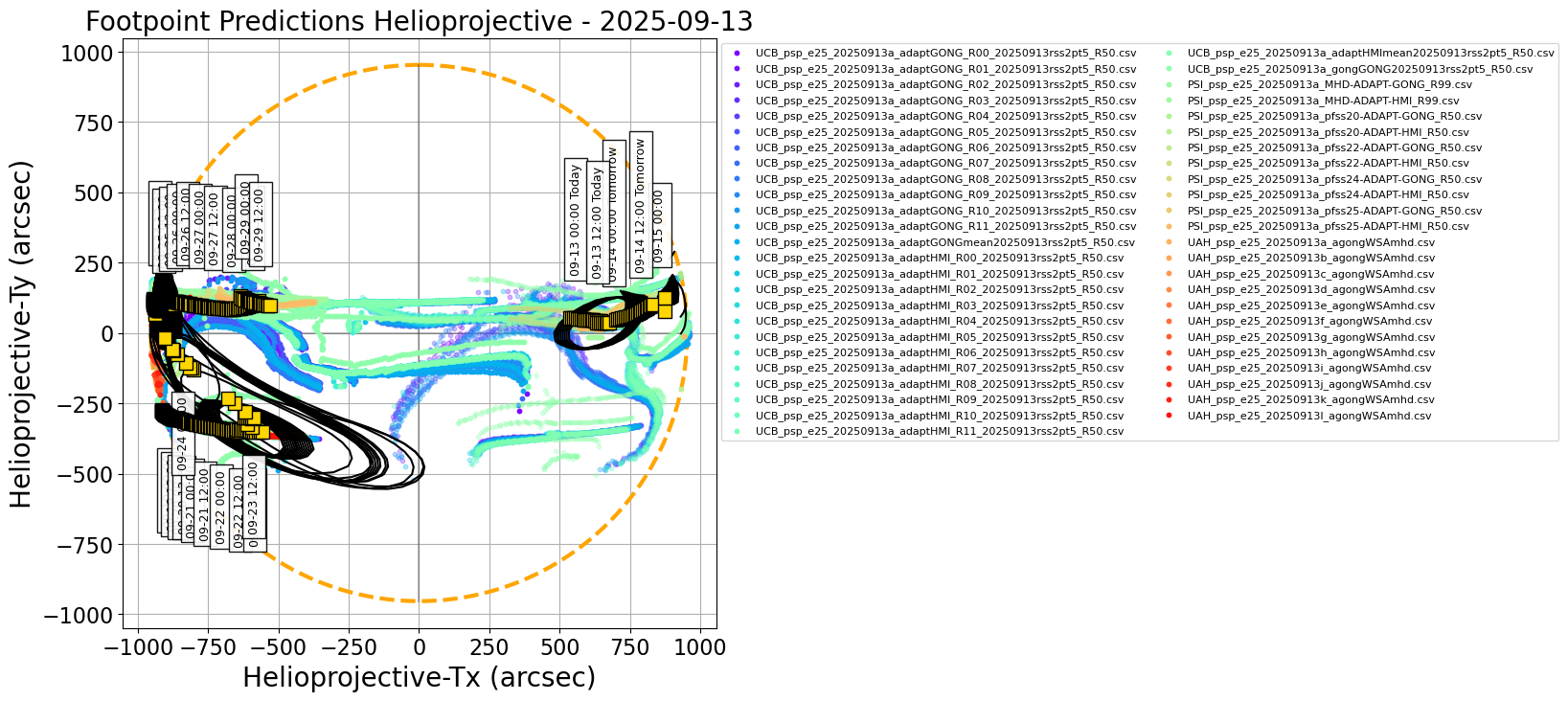
Figure 1.

Figure 2.
Figures above show one footpoint per day plotted on the solar disk and in Carrington coordinates (click on figure to zoom and see caption).
The predicted footpoints were kindly provided by the PSP 24rd Perihelion modeling team.
Encounter 25 Prediction update 2/7: 2025/09/13
------------------------------------------------
This is the second of seven daily footpoint predictions being issued through Thursday 9/18 for Parker Solar Probe Encounter 25. This is the fourth time Parker will reach its record-breaking perihelion of 9.86 Rs. Perihelion 25 occurs on Monday 2025/09/15 at 20:22 UT (16:22 EDT). Prior to perihelion, Parker sources concentrate on the West limb. As seen from Earth, Parker will move rapidly towards and beyond the plane of sky. Perihelion occurs on the far side of the Sun as seen by Earth, with footpoints going behind the limb when Parker reaches approximately 14 solar radii. Parker's rapid prograde motion takes it across the far side of the Sun in just a few days and is expected to emerge over the East limb on 09/18 about 25 Rs above the East limb. After this point, footpoints will be slowly changing and primarily associated with any sources or events on the East limb as seen from Earth.
Magnetic Connectivity
---------------------
For the next two days, Parker's footpoints remain anchored to the westward edge of the prominent negative polarity coronal hole observable on disk moving nearing the West limb today (Courtesy of NASA/SDO and the AIA, EVE, and HMI science teams) and moving with it as it rotates towards the West limb. Throughout this time, the spacecraft will be located above the West limb, moving progressively closer to the Sun.
The connectivity is predicted to drastically change in the early morning (~0300 UT) of 9/15, the day of perihelion, where it will cross the HCS and jump from the present source to a large positive polarity coronal hole on the far side of the Sun. Parker's footpoints will rapidly traverse the far side of the Sun over the following few days and cross the current sheet again on 9/16 (~0800 UT) back to negative polarity and change slowly. However, the footpoint sources aren't predicted to re-emerge on the East limb until late on 9/18 (~1800 UT) when a small negative polarity coronal hole is predicted to rotate onto the disk. From this point onwards, Parker's sources will remain near the East limb for many days, and flows off the East limb are expected to be relevant to the in situ measurements.
At this time, Parker will also be directly below Solar Orbiter, which will be near perihelion and in quadrature with Earth over the East limb. Thus, Earth-based limb observations may capture structures that Parker and SolO measure in situ, while SolO remote observations of the central meridian will provide additional context.
Flare Likelihood (CCMC Flare Scoreboard)
----------------------------------------
As of 2025-09-13 at 12:00 UT, the CCMC Flare Scoreboard gave 24-hour average cumulative flare probabilities amounting to 71%, 13% and 4% for GOES C and above, M and above and X-class flares, respectively, somewhat elevated since yesterday. The strongest flare observed over the past 24 hours was a GOES C1.5 at 2025-09-13T08:14 UT, originating most likely at the western solar limb. Sunspot complexes present in the disk include NOAA ARs 14210 - 14211 and 14212 - 14216, mostly on the western hemisphere and close to or on the limb, with the exception of NOAA AR 14216 that is located at approx. 55 deg Eastern longitude. The conspicuous arched coronal hole that Parker is likely connected to, has moved almost entirely to western longitudes.
From the CCMC CME Scoreboard, the situation is the same as yesterday: there is one active Earth-directed CME detected at 2025-09-11T08:53 from an apparent source location S26E3, with a speed between 340 and 423 km/s. This is a partial halo event from SSE that is following a fainter event observed at 2025-09-11T07:53, with piled-up evolution possible. The predicted shock arrival time at Earth-L1 is approx. 2025-09-14T10:00. The crossing is not expected to trigger a higher than moderate geomagnetic event, with projected Kp values in the range [4, 6].
------------------
*** Please note that the "arrival time" and "emission time" and associated Tx/Ty coordinates for both are reported in the consensus CSV file. The attached plots show the "arrival time" (location of source at time that plasma will arrive at PSP). See Parker Footpoint Predictions - Meaning and Terminology for some discussion on these***.
2025-09-14 (CSV, PDF table of coordinates)
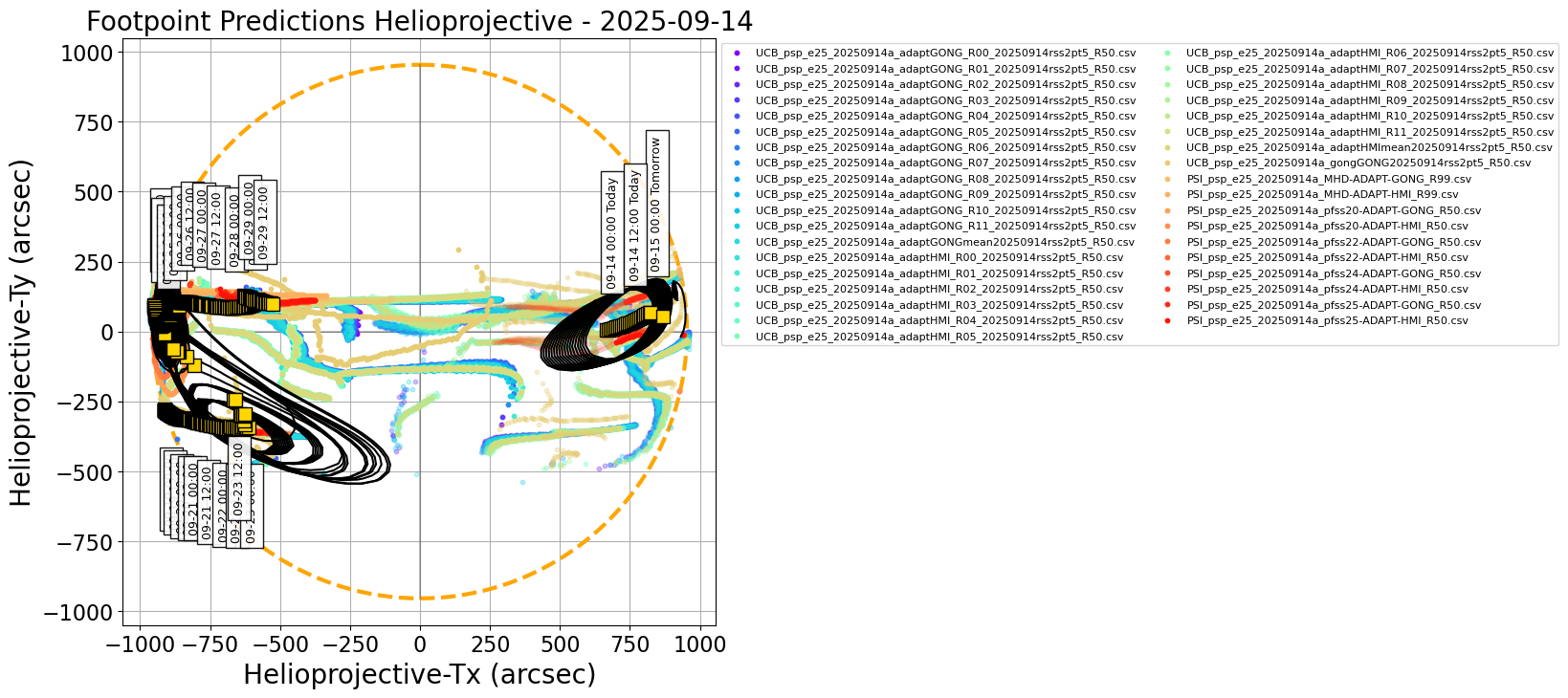
Figure 1.

Figure 2.
Figures above show one footpoint per day plotted on the solar disk and in Carrington coordinates (click on figure to zoom and see caption).
The predicted footpoints were kindly provided by the PSP 24rd Perihelion modeling team.
Encounter 25 Prediction update 3/7: 2025/09/14
------------------------------------------------
This is the third of seven daily footpoint predictions being issued through Thursday 9/18 for Parker Solar Probe Encounter 25. This is the fourth time Parker will reach its record-breaking perihelion of 9.86 Rs. Perihelion 25 occurs tomorrow (Monday 2025/09/15) at 20:22 UT (16:22 EDT). Prior to perihelion, Parker sources concentrate on the West limb. As seen from Earth, Parker is moving rapidly towards and beyond the plane of sky. Perihelion occurs on the far side of the Sun as seen by Earth, with footpoints going behind the limb very early UTC tomorrow as Parker reaches approximately 14 solar radii. Parker's rapid prograde motion then takes it across the far side of the Sun in just a few days and is expected to emerge over the East limb on 09/18 about 25 Rs above the East limb. After this point, footpoints will be slowly changing and primarily associated with any sources or events on the East limb as seen from Earth.
Magnetic Connectivity
---------------------
For today, Parker's footpoints remain anchored to the westward edge of the prominent negative polarity coronal hole observable on disk moving nearing the West limb today, via Solar Monitor, Courtesy of NASA/SDO and the AIA, EVE, and HMI science teams.) and moving with it as it rotates towards the West limb. The spacecraft is located above the West limb, moving progressively closer to the Sun, into and beyond the plane of sky.
The connectivity is predicted to drastically change in the early morning (~0200 UT) of tomorrow (9/15), the day of perihelion, where it will cross the HCS and jump from the present source to a large positive polarity coronal hole on the far side of the Sun. Parker's footpoints will rapidly traverse the far side of the Sun over the following few days and cross the current sheet again on 9/16 (~0900 UT) back to negative polarity and change slowly. However, the footpoint sources aren't predicted to re-emerge on the East limb until late on 9/18 (~1800 UT) when a small negative polarity coronal hole is predicted to rotate onto the disk. From this point onwards, Parker's sources will remain near the East limb for many days, and flows off the East limb are expected to be relevant to the in situ measurements.
At this time, Parker will also be directly below Solar Orbiter, which will be near perihelion and in quadrature with Earth over the East limb. Thus, Earth-based limb observations may capture structures that Parker and SolO measure in situ, while SolO remote observations of the central meridian will provide additional context.
Flare Likelihood (CCMC Flare Scoreboard)
----------------------------------------
As of 2025-09-14 at 12:00 UT, the CCMC Flare Scoreboard gave 24-hour average cumulative flare probabilities amounting to 66%, 11% and 4% for GOES C and above, M and above and X-class flares, respectively, similar to yesterday’s update. The strongest flare observed over the past 24 hours was a GOES C3.5 at 2025-09-14T09:32 UT, originating most likely from NOAA AR 14215 at the western solar limb. Sunspot complexes present in the disk include NOAA ARs 14211, 14213, 14215, 14216, with all but NOAA AR 14216 (at approx. 45 deg eastern longitude) located close to or on the western limb. The conspicuous arched coronal hole that Parker is likely connected to dominates the western hemisphere and is rotating toward mid-western longitudes.
From the CCMC CME Scoreboard, the update is the same as yesterday: there was one active Earth-directed CME detected at 2025-09-11T08:53 from an apparent source location S40E5, with a speed between 340 and 423 km/s. This was a partial halo event from SSE that was following a fainter event observed at 2025-09-11T07:53, with piled-up evolution possible. The shock should have reached Earth this morning (approx. 10:00 UT) but there was no geomagnetic event. The Kp index stayed below 3 and is currently decreasing gradually.
------------------
*** Please note that the "arrival time" and "emission time" and associated Tx/Ty coordinates for both are reported in the consensus CSV file. The attached plots show the "arrival time" (location of source at time that plasma will arrive at PSP). See Parker Footpoint Predictions - Meaning and Terminology for some discussion on these***.
2025-09-15 (CSV, PDF table of coordinates)
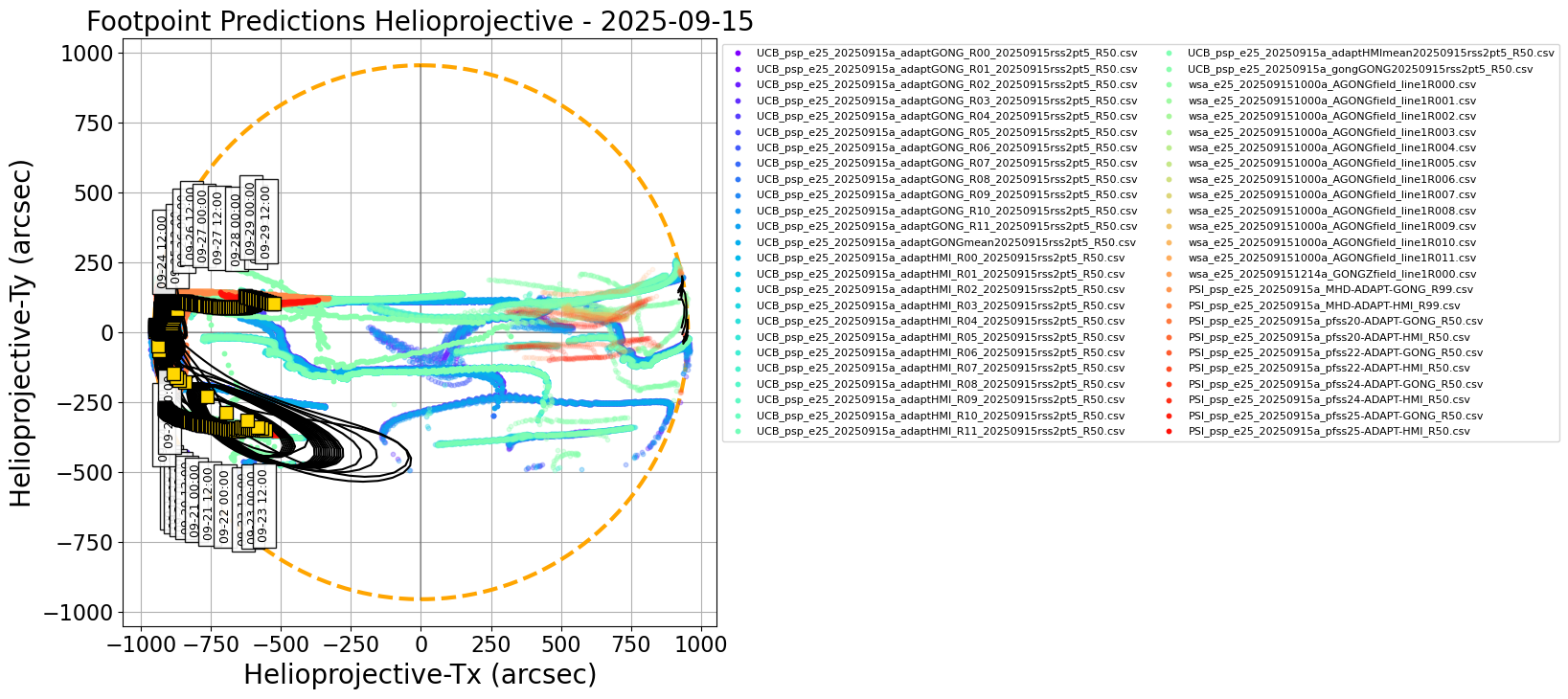
Figure 1.

Figure 2.
Figures above show one footpoint per day plotted on the solar disk and in Carrington coordinates (click on figure to zoom and see caption).
The predicted footpoints were kindly provided by the PSP 24rd Perihelion modeling team.
Encounter 25 Prediction update 4/7: 2025/09/15
------------------------------------------------
This is the fourth of seven daily footpoint predictions being issued through Thursday 9/18 for Parker Solar Probe Encounter 25. Today Parker reaches its record-breaking perihelion of 9.86 Rs fpr the fourth time at 20:22 UT (16:22 EDT). Perihelion, and Parker's footpoints are now on the far side of the Sun as seen by Earth, moving rapidly from the West to East limb. Footpoints are predicted to come on disk over the East limb on 9/18.
Magnetic Connectivity
---------------------
From now until 9/18, Parker's footpoints are associated with far side sources which are not visible from Earth. Observer's may wish to still target the heart/butterfly shaped coronal hole, (or the off-limb region West of it) that Parker was connected to until today.
While on the far side, Parker's footpoints are rapidly traversing towards the East limb. They first connect to a large positive polarity coronal hole that was visible on disk around 10 days ago. It will then cross the current sheet tomorrow (9/16, ~1000 UT) back to negative polarity sources but remain on the far side. These sources will rotate over the East limb late on 9/18 (~1900 UT). From this point onwards, Parker's sources will remain near the East limb for many days, and flows off the East limb are expected to be relevant to the in situ measurements.
At this time, Parker will also be directly below Solar Orbiter, which will be near perihelion and in quadrature with Earth over the East limb. Thus, Earth-based limb observations may capture structures that Parker and SolO measure in situ, while SolO remote observations of the central meridian will provide additional context.
Flare Likelihood (CCMC Flare Scoreboard)
----------------------------------------
As of 2025-09-15 at 12:00 UT, the CCMC Flare Scoreboard gave 24-hour average cumulative flare probabilities amounting to 86%, 11% and 2% for GOES C and above, M and above and X-class flares, respectively. This is somewhat elevated compared to yesterday’s update, particularly for weaker (i.e., C-class) events. The strongest flare observed over the past 24 hours was a C2.2 flare at 2025-09-15T06:41 UT originating from NOAA AR 14216 in the eastern solar hemisphere. Sunspot complexes present in the solar disk include NOAA ARs 14213 and 14215 - 14218. Regions 14216 and 14217 are at mid-to-far eastern longitudes with the rest at far western longitudes or on the western limb. The arched coronal has now rotated almost entirely in the western hemisphere.
From the CCMC CME Scoreboard, there is no Earth oriented CME at the time. However, early in the day (2025-09-15T03:00) the Kp index escalated to just shy of 7, which indicates a moderate-to-strong geomagnetic event. At the moment, the Kp index is approx. 5. The increase in geomagnetic activity should be due to either the CME reported earlier arriving later than expected or due to the deep negative-polarity coronal hole in the Sun, while pile-up effects are possible.
------------------
AIA data is courtesy of NASA/SDO and the AIA, EVE, and HMI science teams.
*** Please note that the "arrival time" and "emission time" and associated Tx/Ty coordinates for both are reported in the consensus CSV file. The attached plots show the "arrival time" (location of source at time that plasma will arrive at PSP). See Parker Footpoint Predictions - Meaning and Terminology for some discussion on these***.
2025-09-16 (CSV, PDF table of coordinates)
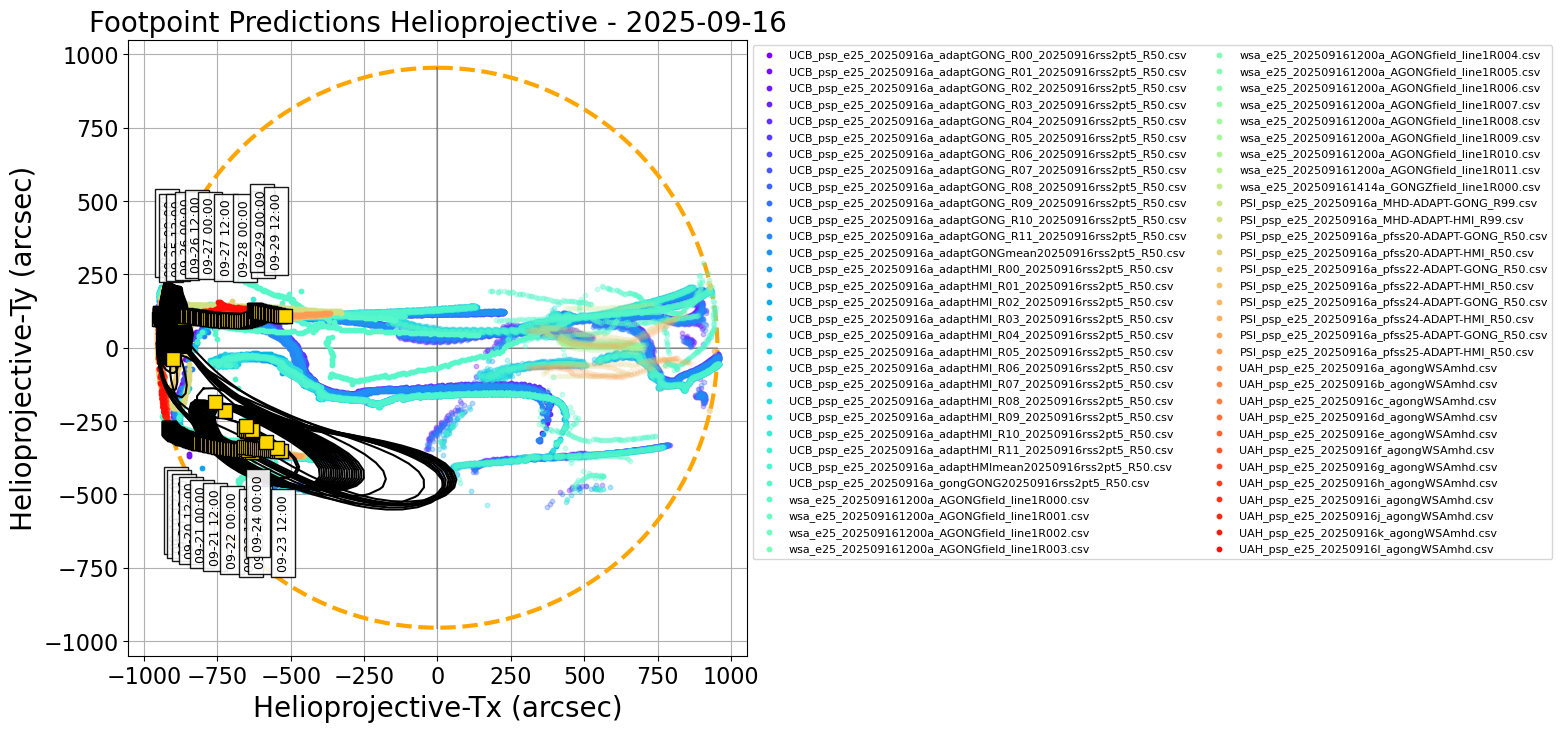
Figure 1.

Figure 2.
Figures above show one footpoint per day plotted on the solar disk and in Carrington coordinates (click on figure to zoom and see caption).
The predicted footpoints were kindly provided by the PSP 24rd Perihelion modeling team.
Encounter 25 Prediction update 5/7: 2025/09/16
------------------------------------------------
This is the fifth of seven daily footpoint predictions being issued through Thursday 9/18 for Parker Solar Probe Encounter 25. Today Parker is on its way back out from perihelion (which reached 9.86 Rs for the fourth time yesterday at 20:22 UT / 16:22 EDT). Parker's footpoints remain on the far side of the Sun as seen by Earth, moving rapidly from the superior conjunction with the Earth to the East limb. Footpoints are predicted to come on disk over the East limb on 9/18.
Magnetic Connectivity
---------------------
Parker's footpoints remain associated with far side sources which are not visible from Earth. Observers may wish to still target the heart/butterfly shaped coronal hole, (or the off-limb region West of it) that Parker was connected to up until a couple of days ago and is currently at the West limb.
While on the far side, Parker is likely to have crossed the heliospheric current sheet earlier today (9/16, ~0900 UT) crossing from positive to negative polarity sources but still remaining on the far side. These sources will rotate over the East limb late on 9/18 (~2100 UT). From this point onwards, Parker's sources will remain near the East limb for many days, and flows off the East limb are expected to be relevant to the in situ measurements.
At this time, Parker will also be directly below Solar Orbiter, which will be near perihelion and in quadrature with Earth over the East limb. Thus, Earth-based limb observations may capture structures that Parker and SolO measure in situ, while SolO remote observations of the central meridian will provide additional context.
Flare Likelihood (CCMC Flare Scoreboard)
----------------------------------------
As of 2025-09-16 at 12:00 UT, the CCMC Flare Scoreboard gave 24-hour average cumulative flare probabilities amounting to 76%, 16% and 2% for GOES C and above, M and above and X-class flares, very similar to yesterday’s update. The strongest flare observed over the past 24 hours was a C3.8 flare at approx. 14:40 UT oday, coming most likely from NOAA AR 14217 in the eastern solar hemisphere. Sunspot complexes present in the solar disk include NOAA ARs 14216, 14217 and 14219 - 14221. All regions except NOAA AR 14219 are now in the eastern hemisphere. The previously reported coronal hole is now at far western longitudes and on the limb.
From the CCMC CME Scoreboard, there is no Earth oriented CME at the time, while the Kp index has been restored to quiet levels (< 4).
------------------
AIA data is courtesy of NASA/SDO and the AIA, EVE, and HMI science teams.
*** Please note that the "arrival time" and "emission time" and associated Tx/Ty coordinates for both are reported in the consensus CSV file. The attached plots show the "arrival time" (location of source at time that plasma will arrive at PSP). See Parker Footpoint Predictions - Meaning and Terminology for some discussion on these***.
2025-09-17 (CSV, PDF table of coordinates)
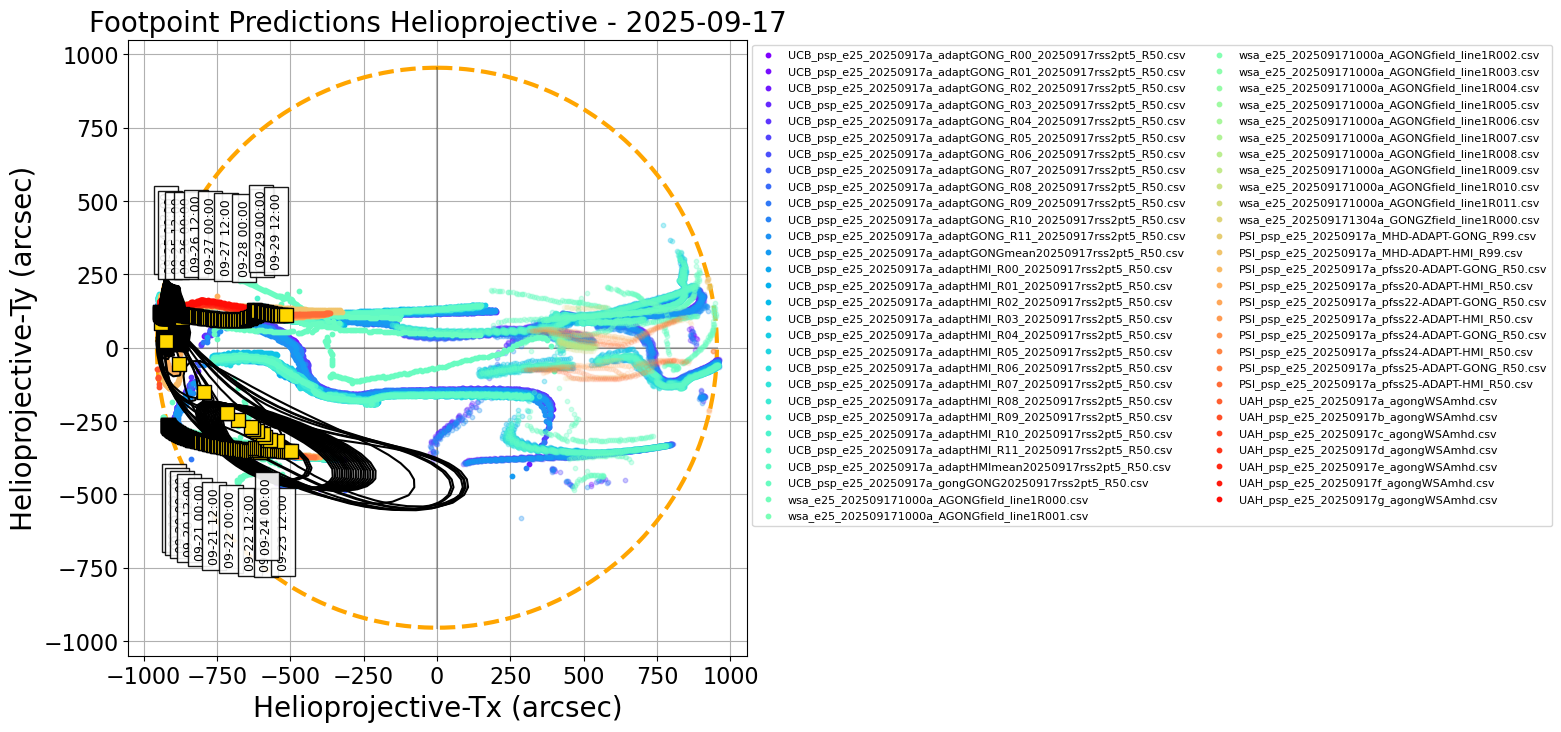
Figure 1.

Figure 2.
Figures above show one footpoint per day plotted on the solar disk and in Carrington coordinates (click on figure to zoom and see caption).
The predicted footpoints were kindly provided by the PSP 24rd Perihelion modeling team.
Encounter 25 Prediction update 6/7: 2025/09/17
------------------------------------------------
This is the sixth of seven daily footpoint predictions being issued through tomorrow (Thursday 9/18) for Parker Solar Probe Encounter 25. Today Parker continues on its way back out from perihelion (which reached 9.86 Rs for the fourth time on Monday 9/15 at 20:22 UT / 16:22 EDT). Parker's footpoints remain on the far side of the Sun as seen by Earth, moving steadily towards the East limb over which footpoints are expected to rotate tomorrow (9/18).
Magnetic Connectivity
---------------------
Parker's footpoints remain associated with far side sources which are not visible from Earth, embedded in negative polarity wind associated with tenuous coronal holes and active region complexes.
These sources will rotate over the East limb late tomorrow (9/18, ~2200 UT). From this point onwards, Parker's sources will remain near the East limb for many days, and flows off the East limb are expected to be relevant to the in situ measurements. In our final update tomorrow we will comment on the nature of these sources and the timeline over which the East limb will remain an interesting target for remote observers.
At this time, Parker will also be directly below Solar Orbiter, which will be near perihelion and in quadrature with Earth over the East limb. Thus, Earth-based limb observations may capture structures that Parker and SolO measure in situ, while SolO remote observations of the central meridian will provide additional context.
Flare Likelihood (CCMC Flare Scoreboard)
----------------------------------------
As of 2025-09-17 at 12:00 UT, the CCMC Flare Scoreboard gave 24-hour average cumulative flare probabilities amounting to 94%, 19% and 1% for GOES C and above, M and above and X-class flares, respectively, similar-to-slightly-elevated compared to yesterday’s update. The strongest flare observed over the past 24 hours continues to be the C3.8 flare reported yesterday, at approx. 2025-09-16T14:40, coming most likely from NOAA AR 14217 in the eastern solar hemisphere. Sunspot complexes present in the solar disk include NOAA ARs 14216, 14217, 14219 - 14225. Only NOAA 14219 is currently located in the western hemisphere. With Parker footpoints about to appear on the Eastern limb tomorrow, Eastern-hemisphere active regions may be of interest for observers to prioritize. The previously reported coronal hole has now rotated almost entirely over the western limb but there is another major coronal hole at the northeastern quadrant.
From the CCMC CME Scoreboard, there is no active Earth-oriented CME at this time. Geospace is at quiet levels, with a Kp index slightly above 3.
------------------
AIA data is courtesy of NASA/SDO and the AIA, EVE, and HMI science teams.
*** Please note that the "arrival time" and "emission time" and associated Tx/Ty coordinates for both are reported in the consensus CSV file. The attached plots show the "arrival time" (location of source at time that plasma will arrive at PSP). See Parker Footpoint Predictions - Meaning and Terminology for some discussion on these***.
2025-09-18 (CSV, PDF table of coordinates)
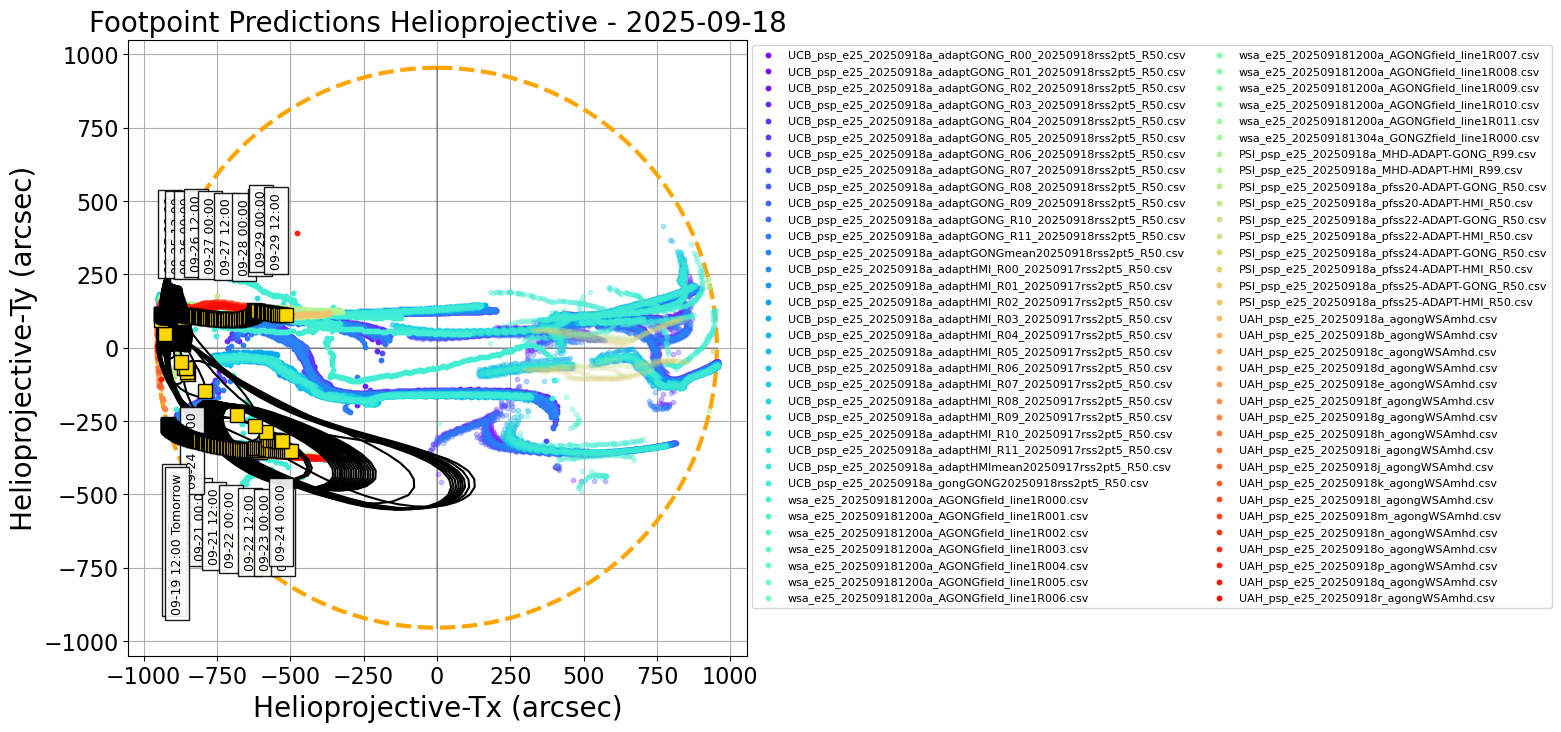
Figure 1.

Figure 2.
Figures above show one footpoint per day plotted on the solar disk and in Carrington coordinates (click on figure to zoom and see caption).
The predicted footpoints were kindly provided by the PSP 24rd Perihelion modeling team.
Encounter 25 Prediction update 7/7: 2025/09/18
------------------------------------------------
This is the final of seven daily footpoint predictions being issued through tomorrow (Thursday 9/18) for Parker Solar Probe Encounter 25. Today Parker continues on its way back out from perihelion (which reached 9.86 Rs for the fourth time on Monday 9/15 at 20:22 UT / 16:22 EDT). Parker's footpoints are expected to rotate onto the East limb late today (9/18) and remain close by as the spacecraft moves steadily further from the Sun.
Magnetic Connectivity
---------------------
Parker's footpoints are expected to be associated with equatorial East limb sources rotating on disk late today (9/18, ~2200 UT). From this point onwards, Parker's sources will remain near the East limb for many days, and flows off the East limb are expected to be relevant to the in situ measurements. At present, these sources appear to be a mix of active region complexes and tenuous coronal holes.
The footpoints will also be directly below Solar Orbiter, which is near perihelion and in quadrature with Earth over the East limb. Thus, Earth-based limb observations may capture structures that Parker and SolO measure in situ, while SolO remote-sensing disk observations will provide additional context.
Flare Likelihood (CCMC Flare Scoreboard)
----------------------------------------
As of 2025-09-18 at 12:00 UT, the CCMC Flare Scoreboard gave 24-hour average cumulative flare probabilities amounting to 88%, 24% and 2% for GOES C and above, M and above and X-class flares, respectively, very similar to yesterday’s update. The strongest flare observed over the past 24 hours was a GOES C2.8 event that occurred at 2025-09-17T23:55 in NOAA AR 14223 in the eastern solar hemisphere. Sunspot complexes present in the solar disk continue to include NOAA ARs 14216, 14217 and 14219 - 14225, with NOAA AR 14219 in the western hemisphere and all other active regions at eastern longitudes. These eastern-hemisphere active regions may be of interest to prioritize given Parker’s expected emergence on the eastern limb at approx. 22:00 UT today. The coronal hole present at the northwestern quadrant is currently approaching the central meridian.
From the CCMC CME Scoreboard, there is no active Earth-oriented CME at this time. Geospace is at quiet levels, with a Kp index value of 2, remaining steady for more than 12 hours.
------------------
AIA data is courtesy of NASA/SDO and the AIA, EVE, and HMI science teams.
*** Please note that the "arrival time" and "emission time" and associated Tx/Ty coordinates for both are reported in the consensus CSV file. The attached plots show the "arrival time" (location of source at time that plasma will arrive at PSP). See Parker Footpoint Predictions - Meaning and Terminology for some discussion on these***.
Date and arrival time of plasma parcel at PSP, consensus carrington longitude (deg), latitude (deg), error in longitude, error in latitude, on-disk position of predicted source in X and Y (arcseconds) at arrival time, date and emission time of plasma parcel at the source, on-disk position of predicted source at time parcel is emitted. Each row is the updated source location each hour.
The consensus is generated by forming a distribution of footpoint predictions from all modelers for each hour period, and attempting to fit a Kent distribution. If the fitting fails, the median in longitude and latitude are quoted. If the fitting is successful, the quoted errors are formed by drawing random samples from the fitted distribution and computing the standard deviation in longitude and latitude of those samples. If the fitting fails, the quoted errors are the standard deviation in the longitude and latitude from the raw distribution of predictions. The full shape of the distribution is described by black contours in the associated plots on this website. More details about the procedure can be found at the following preprint of Badman et al. (2023) "Prediction and Verification of Parker Solar Probe Solar Wind Sources at 13.3Rs"
Please note the carrington coordinates (lon,lat) are valid from the quoted timestamp (in UTC) until the next timestamp. The helioprojective coordinates quoted (HP-Tx, HP-Ty) are computed from the carrington coordinate at the quoted timestamp (e.g. midnight UTC each day) and so are valid instantaneously at this time but will corotate with the Sun until the next quoted timestamp. For a discussion of the subtle difference in emission and arrival time and why both are included please see the slide deck.
Individual model prediction tables of coordinates may be found in a Public DropBox. Files in the Public DropBox have three-letter identifiers indicating the associated model (see below).
Three-letter designation for Public DropBox: UCB. Kindly provided by Sam Badman. The model is a simple ballistic propagation from PSP down to the source surface assuming slow wind 360km/s, and then tracing this sub-PSP trajectory through a PFSS model to get footpoints at the photosphere. The source surface height here is 2.5Rs. The PFSS model is generated using various ADAPT maps with GONG and HMI as input, and the model is run using the open source pfsspy package. A more detailed explanation of the model and comparison to PSP E1 results are given here.
Three-letter designation for Public DropBox: PSI. Kindly provided by Pete Riley. For these predictions, PSI is using a combination of modeling approaches, including PFSS solutions, empirically-based polytropic MHD solutions, and a more sophisticated approach that includes the effects of waves and turbulence to heat the corona and the WKB approximation for wave pressures to accelerate the solar wind. Additionally, boundary conditions are derived from both HMI and ADAPT synoptic magnetograms. Together, these allow us to generate a rich set of ensemble realizations from which to make our optimal prediction, as well as pool them with other teams’ forecasts to derive a hyper-ensemble prediction.
Three-letter designation for Public DropBox: wsa. Kindly provided by Shaela Jones. The Wang-Sheeley-Arge (WSA) model is a combined empirical and physics-based model of the corona and solar wind. The coronal portion of the Wang-Sheeley-Arge (WSA) model is comprised of the Potential Field Source Surface (PFSS) and Schatten Current Sheet (SCS) models, where the output of the PFSS model serves as input to the SCS model. The solar wind portion of WSA consists of a simple 1-D kinematic propagation code that takes stream interactions into account in an ad-hoc fashion. It provides predictions of the solar wind speed and interplanetary magnetic field IMF polarity at any specified point in the inner heliosphere. The WSA model can use global maps of the photospheric magnetic flux measurements from a number of sources as its inner boundary condition; here we are using an ensemble of maps from the Air Force Data Assimilative Photospheric Flux Transport (ADAPT) model, based on input GONG magnetograms.
UAH predictions come from the University of Alabama, Huntsville Multiscale Fluid-Kinetic Simulation Suite (MS-FLUKSS, Pogorelov et al. (2014); Pogorelov (2023); Singh et al. (2022)), which can solve the Reynolds-averaged ideal MHD equations for the mixture of thermal and nonthermal solar wind ions coupled with the kinetic Boltzmann equation describing the transport of neutral atoms. An adaptive mesh refinement technique can be employed for efficient high-resolution calculations. The MS-FLUKSS heliospheric MHD model is coupled with the WSA model (Kim et al., 2020), which uses both ADAPT-GONG and ADAPT-HMI input magnetograms, with the PFSS source surface height and the WSA outer boundary at 2.5 and 10 solar radii, respectively. Hence, field line tracing is performed through the MHD domain down to 10 solar radii instantaneously at approximately 1 hour cadence, where the origin of the field line on the photosphere is already known, as described for WSA.
see Prediction and Verification of Parker Solar Probe Solar Wind Sources at 13.3Rs, Badman et al. (2023)